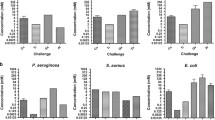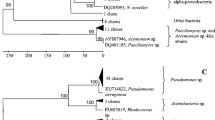Abstract
The non-tuberculous mycobacterium Mycobacterium immunogenum colonizes industrial metalworking fluids (MWFs) presumably due to its relative resistance to the currently practiced biocides and has been implicated in occupational respiratory hazards, particularly hypersensitivity pneumonitis. With an aim to understand its inherent biocide susceptibility profile and survival potential in MWF, five different genotypes of this organism, including a reference genotype (700506) and four novel test genotypes (MJY-3, MJY-4, MJY-10 and MJY-12) isolated in our recent study from diverse MWF operations were evaluated. For this, two commercial biocide formulations, Grotan (Hexahydro-1,3,5-tris(2-hydroxyethyl)-s-triazine) and Kathon (5-chloro-2-methyl-4-isothiazolin-3-one) currently practiced for the control of microorganisms, including mycobacteria, in MWF operations were tested. Effect of the fluid matrix on the biocide susceptibility was investigated for the synthetic (S) and semi-synthetic (SS) MWF matrices. In general, the minimum inhibitory concentration values were higher for the HCHO-releasing biocide Grotan than the isothiazolone biocide Kathon. All genotypes (except the reference genotype) showed lower susceptibility in SS as compared to S fluid matrix for Grotan. However, in case of Kathon, a greater susceptibility was observed in SS fluid for majority of the test genotypes (MJY-3, 4 and 10). The test genotypes were more resistant than the reference genotype to either biocide in both fluid types. Furthermore, the individual genotypes showed differential biocidal susceptibility, with MJY-10 being the most resistant. These observations emphasize the importance of using the resistant genotypes of M. immunogenum as the test strains for formulation or development and evaluation of existing and novel biocides, for industrial applications.


Similar content being viewed by others
References
Beckett W, Kallay M, Sood A, Zuo Z, Milton D (2005) Hypersensitivity Pneumonitis associated with environmental mycobacteria. Environ Health Perspect 113:767–770
Brennen PJ, Nikaido H (1995) The envelope of mycobacteria. Annu Rev Biochem 64:29–63
Chazal PM (1995) Pollution of modern metalworking fluids containing biocides by pathogenic bacteria in France. Re-examination of chemical treatments accuracy. Eur J Epidemiol 11:1–7
Eager RG, Leder J, Theis AB (1986) Glutaraldehyde: factors important for microbicidal efficacy. In: Proceedings of the 3rd conference on progress in chemical disinfection. SUNY, Binghamton, New York, pp 32–49
Falkinham JO (2003) Mycobacterial aerosols and respiratory disease. Emerging Infect Dis 9:763–767
Khan IUH, Selvaraju SB, Yadav JS (2005) Occurrence and characterization of multiple novel genotypes of Mycobacterium immunogenum and Mycobacterium chelonae in metalworking fluids. FEMS Microbiol Ecol 54:329–338
Maillard JY (2002) Bacterial target sites for biocide action. J Appl Microbiol 92:16S–27S
Manzoor SE, Lambert PA, Griffiths PA, Gill MJ, Fraise AP (1999) Reduced glutaraldehyde susceptibility in Mycobacterium chelonae associated with altered cell wall polysaccharides. J Antimicrob Chemother 43:759–765
Moore JS, Christensen M, Wilson RW, Wallace RJ Jr, Zhang Y, Nash DR, Shelton B (2000) Mycobacterial contamination of metalworking fluids: involvement of a possible new taxon of rapidly growing mycobacteria. AIHAJ 61:205–213
Newton GL, Fahey RC (2002) Mycothiol biochemistry. Arch Microbiol 178:388–394
Rawat M, Newton GL, Ko M, Martinez GJ, Fahey RC, Av-Gay Y (2002) Mycothiol-deficient Mycobacterium smegmatis mutants are hypersensitive to alkylating agents, free radicals, and antibiotics. Antimicrob Agents Chemother 46:3348–3355
Rossmoore HW (1995) Biocides for metalworking lubricants and hydraulic fluids. In: Rossmoore HW (ed) Handbook of biocide and preservative use. Blackie Academic & Professional, New York, pp 133–156
Russell AD, Chopra I (1996) Understanding antibacterial action and resistance, 2nd edn. Ellis Horwood, Chichester, pp 223–225
Russell AD (2003) Biocide use and antibiotic resistance: the relevance of laboratory findings to clinical and environmental situations. Lancet Infect Dis 3:794–803
Selvaraju SB, Khan IUH, Yadav JS (2005a) A new method for species identification and differentiation of Mycobacterium chelonae complex based on amplified hsp65 restriction analysis (AHSPRA). Mol Cell Probes 19:93–99
Selvaraju SB, Khan IUH, Yadav JS (2005b) Biocidal activity of formaldehyde and nonformaldehyde biocides toward Mycobacterium immunogenum and Pseudomonas fluorescens in pure and mixed suspensions in synthetic metalworking fluids and saline. Appl Environ Microbiol 71:542–546
Shelton GB, Flanders WD, Morris GK (1999) Mycobacterium sp. as a possible cause of hypersensitivity pneumonitis in machine workers. Emerging Infect Dis 5:270–273
Trout D, Weissman DN, Lewis D, Brundage RA, Franzblau A, Remick D (2003) Evaluation of hypersensitivity pneumonitis among workers exposed to metal removal fluids. Appl Occup Environ Hyg 18:953–960
Uttley AHC, Simpson RA (1994) Audit of bronchoscope disinfection: a survey of procedures in England and Wales and incidents of mycobacterial contamination. J Hosp Infect 26:301–308
van Klingeren B, Pullen W (1993) Glutaraldehyde resistant mycobacteria from endoscope washers. J Hosp Infect 25:147–149
Wilson RW, Steingrube VA, Böttger EC, Springer B, Brown-Elliott BA, Vincent V, Jost KC Jr, Zhang Y, Garcia MJ, Chiu SH, Onyi GO, Rossmoore H, Nash DR, Wallace RJ Jr (2001) Mycobacterium immunogenum sp. nov., a novel species related to Mycobacterium abscessus and associated with clinical disease, pseudo-outbreaks and contaminated metalworking fluids: an international cooperative study on mycobacterial taxonomy. Int J Syst Evol Microbiol 51:1751–1764
Yadav JS, Khan IUH, Fakhari F, Soellner MB (2003) DNA-based methodologies for rapid detection, quantification, and species- or strain-level identification of respiratory pathogens (Mycobacteria and Pseudomonads) in metalworking fluids. Appl Occup Environ Hyg 18:966–975
Acknowledgments
This study was supported by research grant 1R01OH007364 (JSY) from the National Institute of Occupational Safety and Health, Centers for Disease Control and Prevention.
Author information
Authors and Affiliations
Corresponding author
Rights and permissions
About this article
Cite this article
Selvaraju, S.B., Khan, I.U.H. & Yadav, J.S. Differential biocide susceptibility of the multiple genotypes of Mycobacterium immunogenum . J Ind Microbiol Biotechnol 35, 197–203 (2008). https://doi.org/10.1007/s10295-007-0286-5
Received:
Accepted:
Published:
Issue Date:
DOI: https://doi.org/10.1007/s10295-007-0286-5




